the place where Paleontology and Paleoanthropology meets Philately
Bulgaria
Dinosaurs and other prehistoric animals, Nature History Museum, Charles Darwin on stamps and postmarks of Bulgaria
| << previous country | back to index | next country >> |
Contents:
- Country overview
- Philately of Bulgaria
- Official stamps of Bulgaria related to Paleontology
- Other stamps of Bulgaria to consider
- Postal stationery of Bulgaria related to Paleontology
- Commemorative postmarks of Bulgaria related to Paleontology
- References
- Acknowledgements
Bulgaria, officially the Republic of Bulgaria, is a country in southeastern Europe. It is bordered by Romania to the north, Serbia and Macedonia to the west, Greece and Turkey to the south, and the Black Sea to the east.
Bulgaria's population of 7.4 million people is predominantly urbanized and mainly concentrated in the administrative centers of its 28 provinces. Most commercial and cultural activities are centered on the capital and largest city, Sofia. The strongest sectors of the economy are heavy industry, power engineering, and agriculture, all of which rely on local natural resources. [R1]
Bulgaria liberated itself from the Ottoman Empire in 1878 and, although it remained de jure autonomous until the proclamation of full independence in 1908, it acted as a de facto independent country. From 1879, stamps were issued in Bulgarian Cyrillic script. [R2]
Official stamps of Bulgaria related to Paleontology: dinosaurs and other prehistoric animals, Charles Darwin
| 29.05.1971 "Prehistoric animals" [1] | 19.06.1990 "Dinosaurs" | 27.04.1994 " Prehistoric animals" |
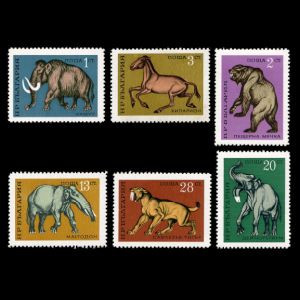 |
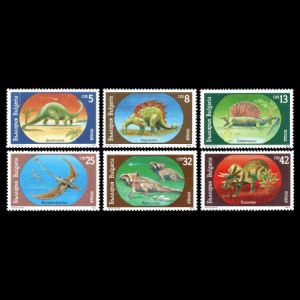 |
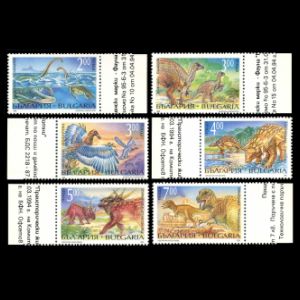 |
| 24.04.2003 "Prehistoric animals" | 06.02.2009 "200th Birthdays of Famous Persons" [2] | 07.04.2023 "Miocene mammals" |
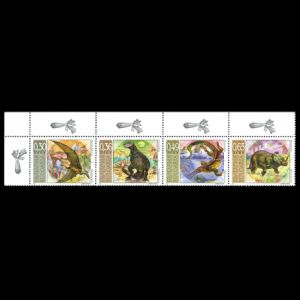 |
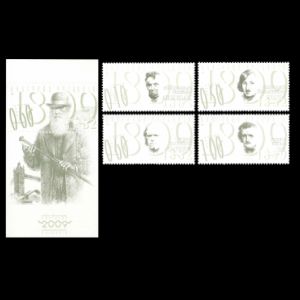 |
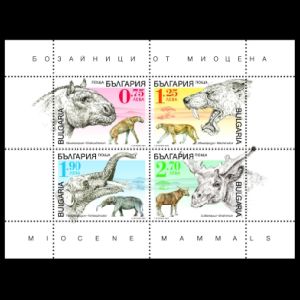 |
Notes:
[1] The first pictorial set of stamp that shows prehistoric animals, issued in Poland in 1965 and was dedicated mostly for dinosaurs.
The first stamps set dedicated to prehistoric mammals issued in Romania one year later. This Bulgarian stamp set is only the second set ever dedicated to prehistoric mammals.
[2] Charles Darwin on a block and one of the stamps from "200th Birthdays of Famous Persons" set.
Other stamps of Bulgaria to consider: contributors to Paleontology science (Carl Linnaeus / Carl von Linne), Natural History museum etc.
| 15.02.1958 "Famous persons (III)" [A1] | 26.10.1964 "Landscapes, definitive set" [A3] | 24.03.2009 "120th anniversary of National Museum of Natural History" |
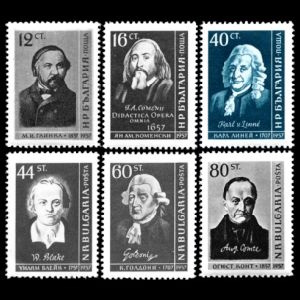 |
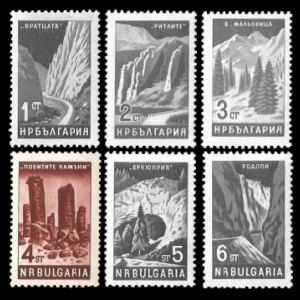 |
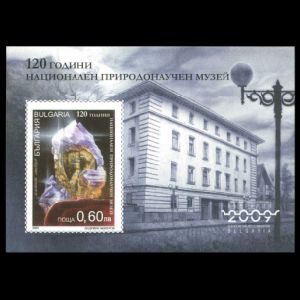 |
| 24.11.2010 "Bulgarian regions" [A3] | 18.10.2018 "Extinct animals" [A4] | |
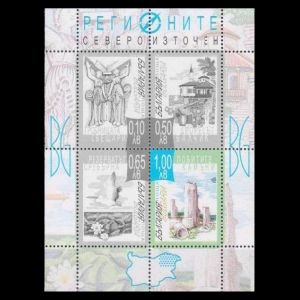 |
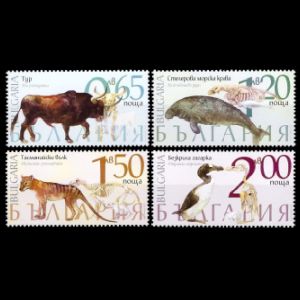 |
|
Notes:

|

|
|
Carl von Linne on stamp of Bulgaria 1958, MiNr.: 1054 Scott: 998 |
Deinotherium giganteum depicted on illustration of official FDC |
[A2] Deinotherium giganteum depicted on illustration of official FDC.
The skull of Deinotherium was also depicted on the postmark on the FDC for this issue. Deinotherium was a large prehistoric relative of modern-day elephants that appeared in the Middle Miocene and survived until the Early Pleistocene.
[A3] The stamp on the right side is a part of 6 values set from 1964, of some Bulgarian landscapes. The stamp on the lower left in the photograph shows Pobiti Kamani (Bulgarian: Побити камъни). Pobiti Kamani is also called the Stone Desert.
The rock pillars shown on the stamp are not examples of not petrified wood, but natural rock formations.
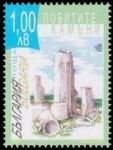
|
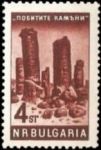
|
|
Pobiti Kamani on stamp of Bulgaria 2010, MiNr.: 4977 Scott: 4588d |
Pobiti Kamani on stamp of Bulgaria 1964, MiNr.: 1473 Scott: 1375 |
The formations are dominated by stone columns between 5 and 7 meters high and from 0.3 to 3 meters thick. The columns do not have solid foundations, but instead are hollow and filled with sand. The columns look like they were stuck into the surrounding sand. A wide variety of hypotheses have been proposed for their origin – and divide roughly into two groups of ideas: organic or mineral origins. The organic origin suggests that these are corals – though no coral material has ever been identified at this site. Non-organic hypotheses include prismatic weathering related to winds and desertification or the formation of sand and lime concretions.
Some of the concretion models suggest that venting of gases from hydrothermal vents or Lower Eocene bubbling reefs led to the precipitation of minerals in columns above the vents.
This site was protected as a natural area in the 1930’s. Now it is a UNESCO World Heritage Site. [R3]
[A4] On October 18th, 2018, Bulgaria issued a set of stamps titled “Extinct Animals”. The stamp set issued in a block with normal paper and with paper able to reflect UV-light and shows the following animals:
The aurochs (Bos primigenius), the Steller's sea cow (Hydrodamalis gigas), the Tasmanian tiger (Thylacinus cynocephalus), the great auk (Pinguinus impennis)
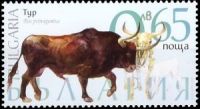
|
|
The aurochs (Bos primigenius) on extinct animal stamps of Bulgaria 2018, MiNr.: 5383 Scott: |
Due the fact that the aurochs appears on many prehistoric cave paintings it can be consider for PaleoPhilately collectors. The stamp with the Aurochs issued also in a block and it appears on associated postal stationery. The postmark on first day cover (FDC) shows its skull and its skeleton shown on illustration of the cover.
Postal stationery of Bulgaria related to Paleontology: fossils, dinosaurs and other prehistoric animals
| 24.04.2003 "Prehistoric animals" | 24.03.2009 "120th anniversary of National Museum of Natural History" | |
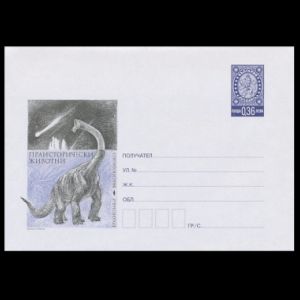 |
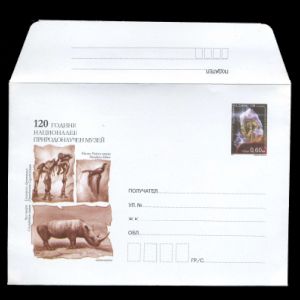 |
|
Commemorative postmarks of Bulgaria: fossils, dinosaurs and other prehistoric animals
Legend is here29.05.1971 "Prehistoric animals" [FDC]
| 19.06.1990 "Dinosaurs" [FDC]
| 27.04.1994 " Prehistoric animals" [FDC]
| |
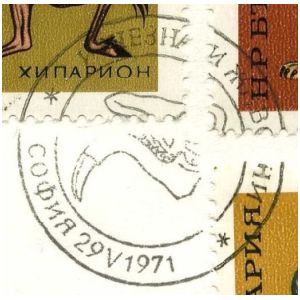 |
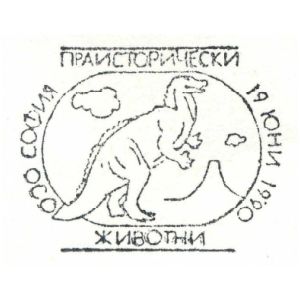 |
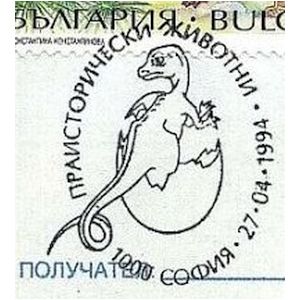 |
24.04.2003"Prehistoric animals" [FDC]
| 07.04.2023 "Miocene mammals" [FDC]
|
| |
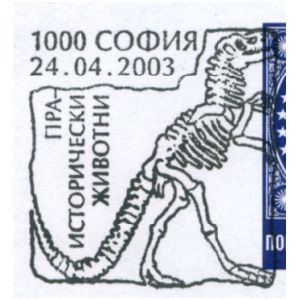 |
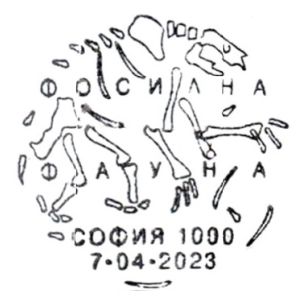 |
|
References:
- [R1] Bulgaria: Wikipedia, WikiTravel, FlagCounter.
- [R2] Postal History and Philately of Bolivia:
Wikipedia,
Links to official website of the Post Authority, stamp catalog and a list of new stamps of Bulgaria are here. - [R3] Pobiti_Kamani: Wikipedia
- [R4] Aurochs: Wikipedia
Acknowledgements:
Many thanks to Dr. Peter Voice from Department of Geological and Environmental Sciences, Western Michigan University, for the draft page review and his very valuable comments.
| << previous country | back to index | next country >> |